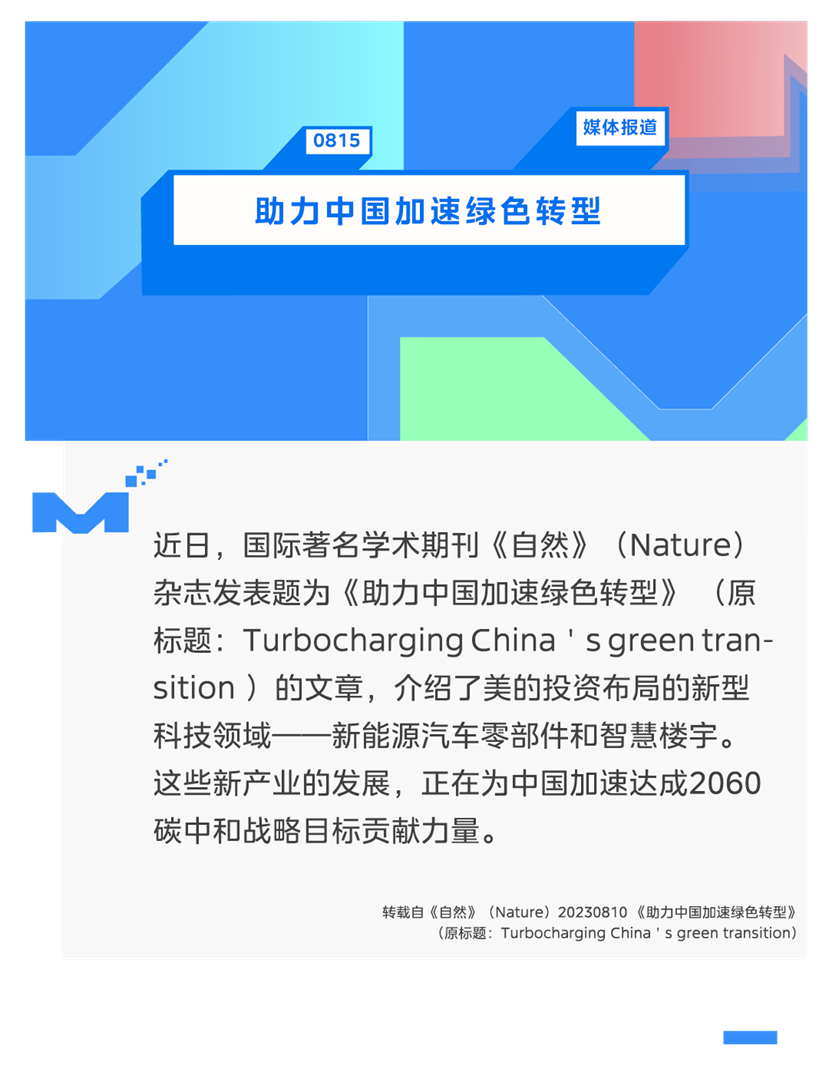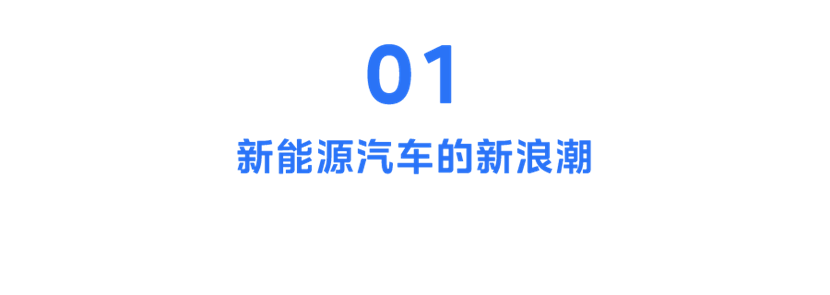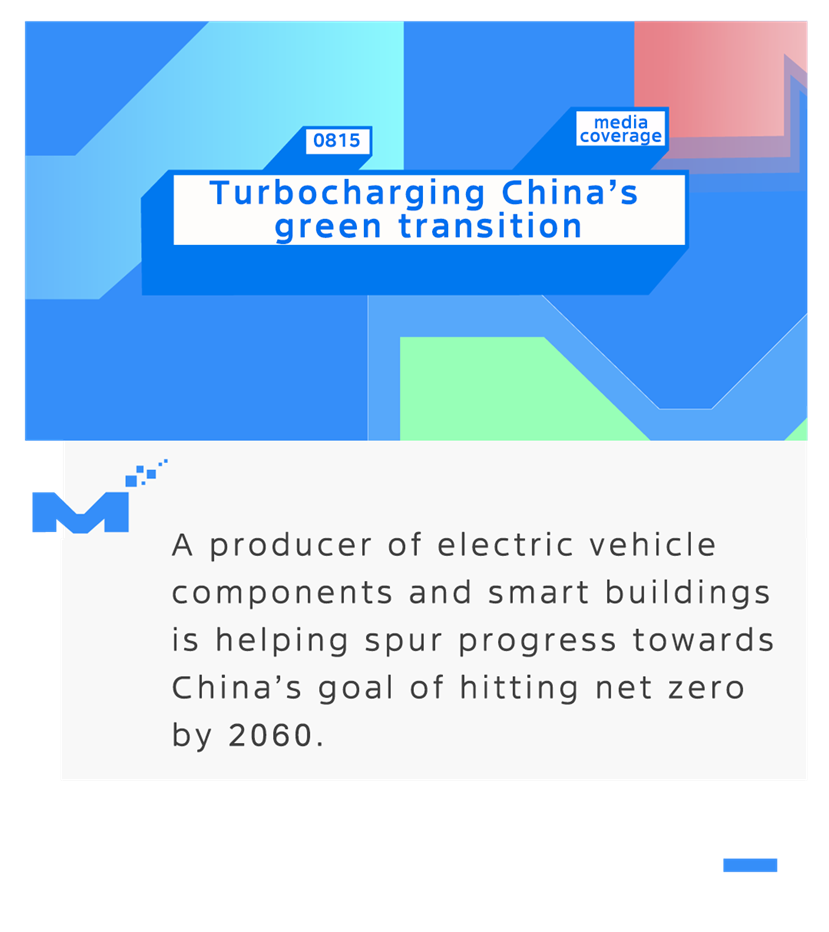Nature特别报道,美的助力中国绿色加速转型

作为推动全球低碳化发展的重要力量,中国于2020年发布了“双碳”目标,即2030年实现碳达峰,2060年实现碳中和。为了达成这些目标,需要在一些领域进行切实的创新性投资,尤其是一些新型科技领域,比如新能源汽车、智慧楼宇。
许多企业正在积极投身并引领行业向零碳方向发展,这其中就包括全球最大的家电制造企业美的集团。美的以可持续发展的理念,成立了专门的业务单位,推动新能源汽车和智慧楼宇产业的发展。

美的正在新能源汽车热管理领域进行重点突破,“新能源汽车的产业布局是美的未来非常重要的战略方向之一”, 美的工业技术汽车压缩机先行研究专家杨工说,目前新能源汽车整车制造赛道相对拥挤,而关键核心零部件中资供应商偏少。
纯电动汽车的热管理系统相比普通燃油车型则更加复杂,这是由于纯电动汽车拥有电池、控制器以及电动机等更多需要进行热控制的部件。杨工介绍,这其中面临三大主要挑战:热回收难、效率低;部件之间协同性差;增加体积带来的重量与成本提升。
要化解这些困难,美的团队进行了如下创新:一是开发出一款800V SiC 12,000rpm高转速电动压缩机,真正提升整车快充效率,还降低了车损坏几率和零部件占用空间;二是结合三角循环加热技术,使热量更均匀分布,使电动压缩机达到更大的电机/电控热功率、更高的结构强度以及更强的抗液击能力,因此能更好地实现高压充电和低温制热;最后是通过运用高强度铝合金和行业首创的一维及三维联合仿真技术,使整体重量再减少1kg,从而优化复杂系统的设计,降低整体能耗。
不但能够更好地实现制冷和制热,杨工介绍道,“还能最大程度缩小压缩机体积和重量,满足超快充的同时,增强用户驾驶的舒适性。”

新能源汽车对于减碳关系重大,中国每年超过10%的碳排放来自于交通领域。不过,建筑相关领域的碳排放量更大,2020年达到50.8亿吨,占中国全面总排放量的51%。“超过一半的建筑碳排放来自于暖通空调(HVAC)与照明。” 美的楼宇科技研究院数字化专家王工说。
近几十年来中国城市化飞速发展,这样的现状使得能够融合可再生能源的智慧楼宇变得尤为重要。
例如,美的为北京大兴机场提供绿色节能的定制化暖通空调解决方案,包括2台全降膜变频离心式地源热泵机组和5台全降膜变频离心式烟气回收热泵机组。据王工介绍,这套解决方案充分利用浅层地热、烟气余热以及污水废热等可再生能源,实现冬季供暖和夏季制冷,这样可以每年节约天然气1736万立方米,每年减少碳排放18000吨以上。
“北京大兴机场是目前中国最大的多能互补地源热泵工程,将环保节能的社会效益与降低能源成本的经济效益有效统一,我们重新定义了机场未来的绿色能源新模式。”

强大的智慧楼宇能源解决方案需要一整套数字科技和数字化平台。美的楼宇科技基于不同的行业和场景,以iBUILDING美的楼宇数字化平台为核心,为用户提供包括顶层设计、建筑实施及后期运维、升级服务在内的数智建筑全栈式解决方案。iBUILDING的智慧楼宇云边一体架构的云端覆盖知识中台、算法中台、业务中台、数据中台和技术中台五大核心板块。
“此外,iBUILDING还支持应用开发的开放平台,以可视化数据分析工具满足数据分析师、数据开发工程师、数据科学家的分析需求”,杨工介绍,“它还支持实时计算、离线计算、BI数据分析、AI机器学习等场景的使用需求,通过数据开放、共享、流动和丰富的接口支持更多第三方,实现上下游业务协作,共创智慧楼宇数字化的行业生态。”
美的也在不断应用自己研发的智慧楼宇科技。比如美的工业园西区,美的楼宇科技数智低碳解决方案从建造到运营等全生命周期都对其进行了赋能:一是应用美的生产的暖通空调、数智电梯产品;二是运用楼宇自控、智慧照明、智慧运营等技术;三是采用太阳能光伏发电、高效储能等新能源路径;最后是以灵动办公、无界会议和智慧通行为抓手打造了智慧办公。
《自然》杂志最后总结道,从创新提升能源效率、整合利用可再生能源,到倡导可持续发展实践,像美的这样的企业,在助力中国低碳经济转型上发挥着重要作用,同时也推动全球的绿色发展进程。
原文链接:https://www.nature.com/articles/d42473-023-00249-8

China generates one third of all greenhouse gas emissions, meaning that a successful drive towards net zero will have far-reaching positive consequences for people all over the world. In 2020, it announced its ambitious “dual carbon” goal: to see its emissions hit their peak and then start to fall in 2030 and for the nation to achieve carbon neutrality by 2060.
Hitting these targets will require a substantial investment in innovation, particularly in emerging technologies such as electric vehicles (EVs) and smart buildings. Already a world leader in solar power, China is now leveraging its manufacturing expertise for rapid decarbonization.
Many companies are now leading the charge to net zero, such as Midea Group, the world’s largest manufacturer of electrical appliances, headquartered in Shunde, Guandong. The company has rapidly responded to the nation’s environmental targets and launched new divisions — focusing on electric cars and smart buildings — with sustainability in mind.

Rather than producing EVs themselves, Midea is leveraging its expertise in heat management to produce critical components to support the industry. “EVs are one of the crucial strategic directions for Midea‘s future", says Guoyong Yang, the company’s senior research engineer, noting that the field of EV manufacturing is relatively crowded, with just a handful of domestic suppliers of core components.
Compared to ‘conventional’ cars with combustion engine cars, electric cars require more complex thermal management due to the additional components that must be kept cool, such as the battery, electric motor, and EV controller that controls the power flow and motor operation.
These requirements present three major challenges, Yang explains: low efficiency due to the difficulty of effectively harnessing and recovering heat; the problem of coordinating multiple components; and an addition of bulk that increases weight and cost.
Addressing these challenges required multiple innovations. Firstly, the team developed an electric compressor capable of reaching 12,000 rotations per minute (rpm). This high speed enables the compressor to heat and cool efficiently, with just 40cc of power, it can achieve a cooling capacity of 14kW, surpassing the industry standard of 10kW for 45cc.
When combined with a triangular-cycle heating technology that distributes heat evenly, the compressor is able to handle higher motor and electronic control heat, making it suitable for high-voltage charging and low-temperature heating. Finally, the team was able to shave off 1kg of weight by using high-strength aluminium alloy and simulations that allowed for more accurate predictions and optimized the design of complex systems.
Not only has the product achieved better cooling and heating, says Yang, “it has also achieved ultra-fast charging while enhancing the driving comfort for users.”

EVs are undoubtedly essential to decarbonization. CO₂ emissions from the transportation sector account for more than 10% of China’s total emissions. But building-related emissions are an even bigger contributor, generating 5.08 billion tons of CO₂ in 2020, and accounting for 51% of China’s total emissions.
More than half of a building’s emissions come from heating, ventilation and air conditioning (HVAC) — along with lighting — says Zuozhong Wang, Head of the Digital Business Architecture Center at Midea Building Technologies.
This fact makes smart buildings that optimize energy consumption and integrate renewable energy of huge importance to reducing China’s emissions, a nation where urban sprawl and resultant construction have exploded in recent decades.
At Beijing’s massive Daxing International Airport, Midea’s customized, energy-efficient HVAC solutions include two ground-source heat pump units and five flue gas heat recovery pump units. According to Wang, these solutions make full use of shallow geothermal energy, flue gas waste heat and sewage waste heat, to achieve highly efficient heating during winter and cooling during summer. This saves as much as 17,36 million cubic meters of natural gas a year and reduces annual carbon emissions by more than 18,000 tons.
“The Beijing Daxing project is currently the largest multi-energy heat pump project in China,” explains Wang. “By combining the social benefits of environmental protection with the economic benefits of reduced energy cost, we are redefining how airports can be powered with green energy.”

Powering these energy savings requires a complete set of digital technologies and platforms, from the user interface to the underlying infrastructure, providing a comprehensive digital solution. Midea’s solution is the iBUILDING platform, which enables top-level design, implementation, operation and maintanence as well as upgrading services. Using both cloud computing and edge technology, iBUILDING covers five key areas: insights, algorithms, business operations, data and technology.
“In addition, iBUILDING is an open platform that supports application development, with visual data analytic tools to meet the needs of data scientists and engineers”, says Wang. “It also supports real-time computing, business insight analysis, machine learning and other scenarios. Data sharing and rich interfaces also allow third parties to collaborate, creating a vibrant smart building digital ecosystem.”
Midea is itself an active user of its own smart building technology. At the Midea Industrial Park West for example, the company’s LIFE low-carbon solutions are being used across a building’s entire life cycle, from construction to operations.
Firstly, Midea’s HVAC and intelligent elevators are integrated at the design phase, while building automation, smart lighting and intelligent operation and control are used to improve efficiency. The buildings are also designed to be run on green energy, with built in solar panels and high-efficiency energy storage. Finally, users enjoy a smart and secure office with Midea’s flexible configurations and intelligent access control.
By innovating on energy efficiency, renewable energy integration and advocating for sustainable practices, companies like Midea can play a vital role in helping China transition to a low-carbon economy and help the entire world in the process.
【艾肯网版权与免责声明】:
1、凡本网注明"转载:其他(非艾肯网)"的内容,均转载自其它媒体或企业供稿(包括供稿配图),转载目的在于传递更多信息,不代表本站赞同作者观点,本站不对内容的准确性、可靠性或完整性提供任何明示或暗示的保证。
2、凡本网注明"原创"的内容,均为艾肯网原创,转载时请在显眼位置标注"来源:艾肯网"。
3、如果发现本站有涉嫌抄袭的内容或者使用了版权图片,请与我们联系QQ:1833597079 ,一经查实,本站将立刻删除侵权内容或版权图片。艾肯家电网将不承担任何法律及连带责任。
附则:对免责及版权声明的解释、修改及更新权均属于艾肯网所有。